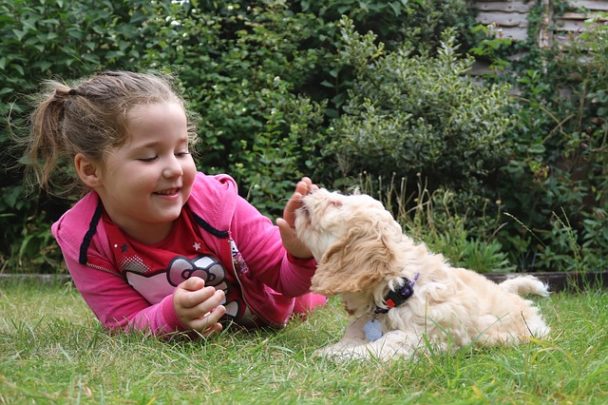
Have you ever heard the phrase, ‘never work with kids or dogs’? I always giggle when I hear people say that, because I love working with the two together! I adore children and have made my career helping dogs and their families live harmonious lives. But it’s not always little boys and puppy dog tails.
Having both dogs and children can be an amazing adventure, but it most definitely is serious business. According to the American Veterinary Medical Association’s website, “most dog bites affecting young children occur during everyday activities and while interacting with familiar dogs.” If you have chosen to raise both, then have fun, but pay attention.
Learn about body language and behavior
If you want to be able to teach your children how to interact safely with a dog, you first need to be aware of your dog’s behavior and what he is trying to say. If you do not have at least a basic understanding of subtle dog body language, then your child is at risk. It’s important to learn and understand when your dog is truly happy, and when he is starting to get a little stressed or uncomfortable.
Active supervision
Once you have an understanding of what your dog is saying, the next step is to actively supervise both your dog and your children. By now, you have heard that dogs and children need to be supervised at all times. But what does this really mean? It means that when your child and dog are in the same room, a parent needs to be involved and conscious of what is going on. In other words, if Fluffy is sleeping in her dog bed in the living room and Sally is playing with her toys in the living room, a parent should not step out of the room, or be occupied on the computer or phone. Or, if Sally is playing fetch with Fluffy, the parent should be interacting with both Sally and Fluffy in the game. Things can happen very quickly, tail pulling, flailing of hands, or jumping up.
Teach your child how to interact with a dog
As a parent, it is your responsibility to continually teach your child how to interact with a dog. Your lessons will depend on your child’s age and ability to comprehend. It’s important to realize that learning how to properly interact and play with a dog is an ongoing life lesson. You should teach your child things like polite petting, not screaming, being calm around a dog, not taking a dog’s bones or food, not sitting on dogs, and being gentle with a dog.
Teach your dog how to interact with children
You will also need to teach your dog how to be polite around kids, too. A few basic manners and behavioral cues can go a long way in a happy relationship. Important basic manners are things like not jumping, not mouthing, and sitting politely for games. A few behaviors that can come in handy are sit, retrieve, drop it, and leave it.
Management tools
If you can’t be hands-on, then you should be proactive in using a management tool. Children who need to be told over and over again what to do or not do are not mature enough to have unsupervised access to a dog. There is no magic age; it truly is about your child’s reliability and your puppy’s behavior. You can use management tools to keep your children and dog separated when you are not able to reliably interact with the pair. Items like baby gates, crates, and closed doors are perfect in these situations.
Dogs and kids can be a ton of fun together, and with the right guidance, can develop an amazing relationship. If you ever are unsure about your dog’s behavior around your children, seek the guidance of a dog behavior specialist.
